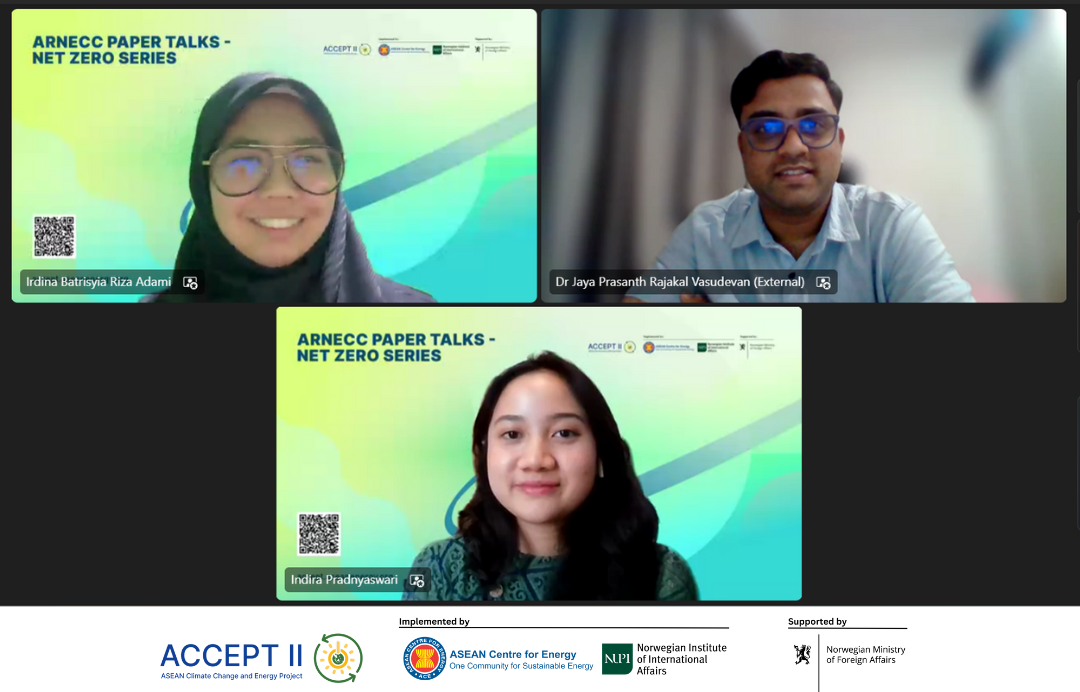i
i
Online, 30 May 2024
ARNECC Paper Talks 2.0 webinar series is back with its seventh episode. This monthly virtual discussion is the flagship event of the knowledge-sharing platform ASEAN Researchers Network on Energy and Climate Change (ARNECC), which pools academia members and related stakeholders. As the research driver of the ASEAN Climate Change and Energy Project (ACCEPT) Phase II, it aims to shed light on broad issues within Southeast Asia’s energy-climate nexus.
On May 30th , 2024, ACCEPT II hosted Dr. Jaya Prasanth Rajakal from Sunway University to present his team’s findings from the freshly published academic paper “Analysis of current state, gaps, and opportunities for technologies in the Malaysian oil palm estates and palm oil mills towards net-zero emissions”. It analysed decarbonisation pathways of the Malaysian palm oil chain, emphasising the upstream and midstream segments. These are the plantation process, palm oil milling, and the associated transportation during the two processes. This discussion was moderated by Indira Pradnyaswari, ACCEPT II Associate Research Analyst, while Irdina Batrisyia, ACCEPT II Research Assistant acted as the master of ceremony.

Figure 1. Dr. Jaya Prasanth Rajakal (top right) posed with moderator Indira Pradnyaswari (bottom) and master of ceremony Irdina Batrisyia (top left)
The research was borne out of the urgency to decarbonise Malaysia’s palm oil industry as the country strives to be carbon neutral by 2050. Malaysia is known as the second-largest worldwide palm oil producer and exporter; 3% of its GDP came from this industry. Yet, greenhouse gas emissions (GHG) from the industry can reach as high as 3579.37 kgCO2/t CPO, roughly contributing 3% to the country’s yearly emissions. Dr. Rajakal et al’s research was to bridge the gap to net zero by assessing the potential technology mix on the upstream and midstream process in palm oil mills to reduce the greenhouse gas generation from selected areas.
Sources of emissions in the upstream and midstream segments are shown in Figure 2. It is surprising to learn that more than 70% of the emissions are categorised as Scope 2 emissions—39% of emissions originated from palm oil mill effluent (POME), followed by 32% from palm biomass degradation. Both are also byproducts from the milling process in the midstream segment and are considered emission sources when they are left discarded and unutilised. The biomass itself has a lot of variety; notable ones are empty fruit bunch (EFB), palm kernel shell, and palm mesocarp fibres. Some of these biomasses can be utilised using current technologies and practices, such as mulching oil palm fronds, combined heat and power (CHP) power systems, direct cofiring of PKS in coal plants, and POME anaerobic digestion. However. merely utilising them is not enough to fully decarbonise the identified baseline emission, creating a 31.20% net-zero gap.

Figure 2. Emission sources within the upstream and midstream parts of the supply chain
Dr. Rajakal et al figured that EFB utilisation remains limited in the industry. Hence, his team discovered several technological options in combining EFB utilisation techniques with current other biomass utilisation technologies. They modeled the pathways into two scenarios and compared their efficiency in reducing a baseline emission level. Dr. Rajakal highlighted that the EFB-briquette and EFB-pellet pathways managed to surpass the 31.20% net-zero gap both in scenario 1 (19% and 1.51%, respectively) and scenario 2 (15.87% and 5.47%, respectively). Both technologies high level of technological readiness (TRL 7), suggesting commercial implementation will be possible if economies of scale are reached. Both technologies can also generate revenue, solidifying them as a superior option compared to other pathways shown in Figure 3.

Figure 3. Net-zero and revenue status summary for each pathway options
Despite implementing this would be challenged by scaling up problems, Dr. Rajakal is confident that government support can accelerate the process. It can be in the form of clustering oil mills and connecting each group with biorefineries, hence driving economies of scale. He conveyed that this is something that the Malaysian government is working out as despite the policies being yet to be released, their intention is strongly signaled by the launch of the National Biomass Action Plan. There is also an observed “lack of urgency and understanding” among operators and key players, suggesting the need for public awareness to reach critical mass on demanding changes in the market.
In terms of the way forward, Dr. Rajakal mentioned that there are possibilities to incorporate other technological applications, notably in utilising carbon capture and storage (CCS), as the biogenic emissions captured can be stored in offshore locations that the Malaysian government is developing. While this technically feasible application will need measures to make it economically viable, it is an opportunity for the creation of carbon credits. As for the research itself, room for improvement exists, especially in expanding the study to incorporate Scope 3 emissions and acknowledging supply chain uncertainties using a stochastic model. Yet, Dr. Rajakal underlined that government support is overarchingly crucial in ensuring the techno-economic harmony of decarbonising the palm oil industry. Indira similarly concluded the discussion by stating that stronger political will is required to propel the decarbonisation drive forward.
(SNF)
Join our ASEAN Researchers Network on Climate Change (ARNECC) by registering yourself here. Become a part of our collaborative efforts to address pressing climate challenges and shape a sustainable future.
Detailed information on ACCEPT II can be found at https://accept.aseanenergy.org/
We welcome any future collaboration, please feel free to contact us at [email protected]